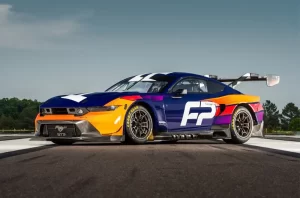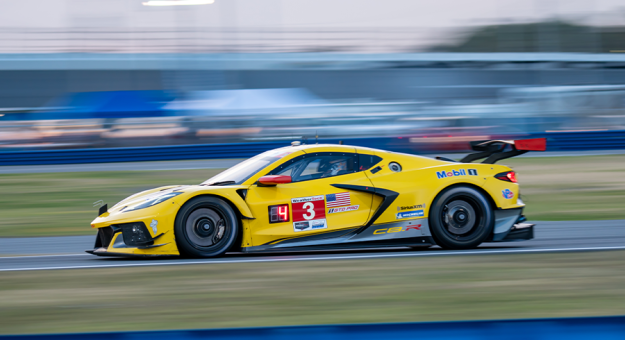DAYTONA BEACH, Fla. — The rivalry between Ford and Chevrolet has existed almost as long as the American automotive industry. But two of their most historic and iconic models – the Chevy Corvette and the Ford Mustang – were never direct competitors.
Until now.
Prevailing trends toward trucks, SUVs and electrification have left the Mustang and the Corvette standing alone as the last internal combustion engine (ICE) powered cars in the Ford and Chevrolet vehicle lineups. Call it an auto industry version of the reality show “Survivor,” with Mustang and Corvette the last cars on the island.
Both started as auto show concept cars that made it all the way to production, but the modern Corvette and Mustang are otherwise dissimilar vehicles.
With a 150-horsepower “Blue Flame” straight-six and two-speed “Powerglide” automatic transmission, the Corvette that debuted in 1953 was a limited production dream car that offered far more show than go. Chevrolet struggled to sell 300.

Similarly, when Ford launched the Mustang in April 1964, it was intended to be a sporty and stylish version of the Falcon compact sedan, pitched at the youth market. It exceeded all expectations by selling nearly 420,000 units in the first year of production, in the process creating a genre of sporty American coupes known as “Pony Cars.”
Ford had already trotted out the Thunderbird in 1955 in direct response to the Corvette. But by 1960, the Thunderbird had evolved into a four-seater. Ford continued to use the Thunderbird nameplate on a variety of cars over the next five decades, leaving the Corvette as America’s only true sports car.
In fact, after struggling for sales its first few years, the Corvette received an infusion of power and technology and carved its own niche into the automotive cultural landscape. By the time Chevrolet responded to the Mustang with the 1967 Camaro, the Corvette offered numerous performance options that solidly maintained its position as Chevrolet’s halo car.
The auto industry’s so-called “malaise era” – a product of intensifying safety and emissions laws from the late 1960s to early ‘80s – significantly impacted the Corvette and the Mustang. The 1975 Corvette’s small-block V-8 produced only 165 horsepower, the lowest output since the 1953 original. Mustang fared even worse, as the badge was assigned to a four-cylinder compact based on the Ford Pinto from 1974-78.
But as the carmakers mastered unleaded fuel, emission controls, 5-mph bumpers and airbags, Mustang and Corvette rallied. The “Fox” body Mustang based on the mid-size Fairmont platform restored credibility to the Mustang name, especially in 5.0-liter V-8 GT trim. Corvette got a much-needed upgrade to the C4 generation in 1984, and Chevrolet really got serious about polishing the ‘Vette’s performance chops with the 1997 C5.
In the 21st century, Ford kept refining the basic Mustang concept, making the sixth-generation S550 platform introduced in 2014 available for worldwide sale. Meanwhile, the Corvette was developed through C6 and C7 generations into arguably the most capable front-engine sports car in the world. But Chevrolet knew the performance potential of a mid-engine car was even higher, so after decades of rumors and secret prototypes, the mid-engine Corvette became a reality with the current C8 generation.
As a front-engine 2+2 coupe, the Mustang is not a direct rival to the mid-engine, two-seat Corvette. But not only are they soon to be the last surviving ICE cars for Ford and Chevrolet, Mustang and Corvette are closer than ever performance-wise – and pricewise.
You can drive a Corvette out the door for $69,995, which is considered a remarkable bargain for an exotic mid-engine sports car. However, it’s also possible to price out a fully loaded Z06 convertible for more than $180,000!
Meanwhile, a $31,000 base Mustang also packs plenty of bang for the buck. But the big news for 2024 is the arrival of the Mustang Dark Horse, which starting at $65,505 has stepped squarely into Corvette territory in terms of both price and performance.
Not only are production Corvettes and Mustangs now being comparison shopped by consumers, the two famous nameplates will be pitted directly against each other on the track starting in 2024 with homologated GT3 cars in international sports car racing, creating a new venue for Ford vs. Chevrolet competition.
The Ford Mustang Dark Horse GT3 and the Chevrolet Corvette Z06 GT3.R will wage battle in both the Grand Touring Daytona (GTD) and GTD PRO classes of the IMSA WeatherTech Sports Car Championship. The GTD PRO programs are primarily factory efforts, with partner teams Pratt Miller (Corvette) and Multimatic (Mustang).
Corvette and Mustang will continue to evolve. Ford has already spawned the Mustang Mach E, a compact and sporty electric SUV. Rumors persist that GM plans to use the Corvette brand in non-traditional ways, starting with an ICE-powered SUV in 2025.
Whether on the road or on the race track, the Chevrolet Corvette and Ford Mustang are a pair of American success stories that will continue to inspire car enthusiasts for decades to come. Our next installment will take a deep dive into their racing history.
